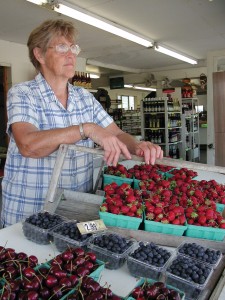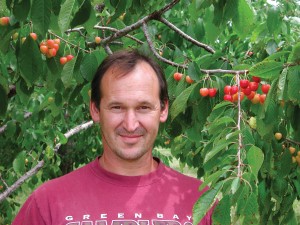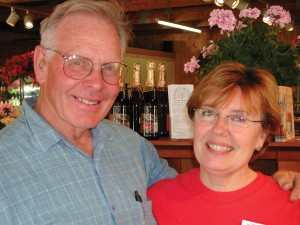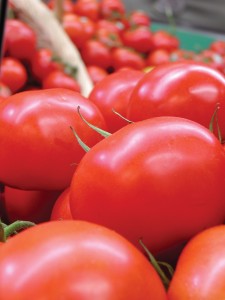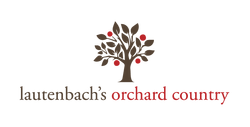Expressions of Tradition
- Share
- Tweet
- Pin
- Share
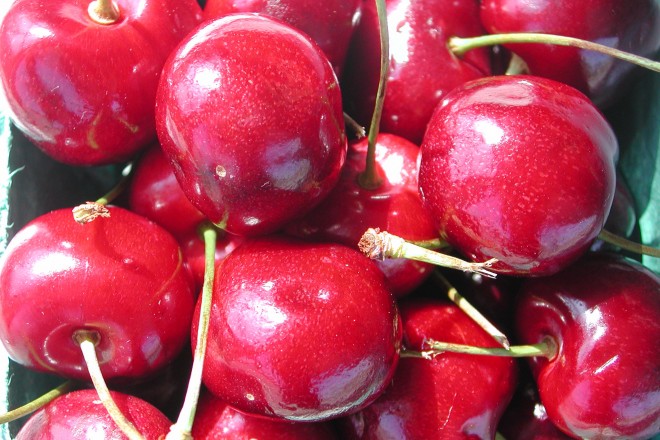
March maple syrup, spring asparagus, vine-ripened summer tomatoes, sweet corn, fall squash…the farm markets of Door County are harvesting the bountiful crops for every season. There are dozens of “off the farm” and “on the farm” markets in Door County, and they offer both specialized crops and the entire gamut of vegetables and fruits. All sizes of farms and orchards offer fresh produce, but there are some very large operations in Door County. In northern Door the Seaquist Orchards Farm Market is the state’s largest cherry producer. Wood orchards are the largest apple growers in the county, and Chaudoir’s in Sturgeon Bay is the area’s largest strawberry grower. But there are innumerable smaller family operations: Raspberry Rowe’s and Don and Pam Richmond’s market in southern Door, and in the north you’ll find the Home Grown Market out of Carlsville, the long-standing Koepsel’s Market just east of Ephraim, or the Knutson’s newly emerging North Bay Road farm off ZZ out of Sister Bay, to name a few.
Farm markets offer expressions of tradition in the farm communities, and also represent enclaves of innovation. It is where the rural and urban often overlap. The organic food niche – which is a $2.8 billion business in the U.S. – has grown about 20 percent in farm markets since the 1990s. Orchards, such as Seaquist’s in Sister Bay, offer opportunities for University of Wisconsin horticulturists to try new varieties of apples or cherries. In other areas farm markets are even producing soy for biodiesel, and hemp and kenaf for fiber. Unusual vegetables are also trialed in farm markets, such as adzuki beans, amaranth, chickpeas, comfrey, Jerusalem artichoke, herbs such as Echinacea, and many others.
Among the many farm markets of Door County is Sugar Mountain Farm Market in Brussels, owned and operated by Eugene and Julia Garbowski. They purchased the land in 1977, and after a long stint of traditional farming, opened the actual farm market in 1991. Now they harvest thirty acres of vegetables on their 80-acre farm in Union; they also pick from an extensive apple orchard. “We have strawberry fields, raspberries and blackberries too,” Julia said. “My husband picks a lot of the vegetables, sometimes with hired help. We sell most at the store here, and at the farmers’ market in Sturgeon Bay’s Market Square on Saturdays.”
With only one full-time helper in the market, and eight part-time employees, Julia and Eugene work hard all season. “Eugene is very efficient,” Julia said, “and plants the fields for different seasons. We start the season with ‘pick-your-own’ asparagus.” She noted that the romance of working a farm market wore off after the first week. “Farming is for people with hard edges because it’s a lot of work.”
Sugar Mountain celebrates several festivals, starting with an early July Strawberry Festival. “The reason for the festivals is to highlight the changing of the seasons,” Julia said. The Belgian Harvest, a traditional farm celebration, is on Sunday, September 7 at the farm market. “We serve all the traditional Belgian food, like booya and trippe pies (sausage and cabbage). Then, on October 5, Sugar Mountain celebrates a Pumpkin Festival, complete with a haunted barn, horse and wagon rides, music, crafts and lots of food — especially everything pumpkin, from pie to bread to muffins, even pumpkin pancakes. “This is also apple season,” Julia said, and their many varieties of apples are featured. “One of the last vegetables we sell are Brussels sprouts on the stalk in October.”
Maple syrup is a favorite in the farm markets, and is locally produced by a number of families, especially the Jorns and the Staats in the Egg Harbor area. Ed and Debbie Staats started their maple syrup concern more than forty years ago. They tap nearly a thousand sugar maples in natural stands on their property. “Nothing has been specifically planted,” Debbie Staats said. “The hard woods are part of the dairy farm lands.” The Staats produce 500 gallons of syrup in an average year. “We’re never quite sure when [the sap] is going to start or stop. We need warm days in the forties and cold night that freeze.” The season can start in mid-March and run to early April in a good year. “We try to process the sap in the first twenty-four hours after collecting it,” Debbie said.
Maple syrup producers need forty gallons of sap to make one gallon of syrup. “The sap is clear when it comes out of the tree, and gets dark when we cook it down,” Debbie said. It is all a function of sugar content. The higher the percentage, the shorter the cooking time, and the lighter the syrup. “Buddy syrup” is very dark with a strong maple flavor, and is typical of the end of the season low-sugar sap.
On the northern edge of the city of Sturgeon Bay you’ll find Zahn’s Green Thumb Farm Market. Owner-operator Gail Zahn is considering closing up shop after the 2003 season, concluding 45 years in the business. “I love the orchard business,” Gail said, “But then all of a sudden you find yourself taking care of your parents, then taking care of yourselves, and so you have to enjoy the in-between time.” Gail, and her late husband Roger, met in the third grade and first dated in their sophomore year in high school. Gail said, “My father was from Ellison Bay, a Swede, and Roger was from Baileys Harbor from a German family. They used to say, ‘Don’t compliment a German, it’ll go to his head!’ and I married a German!” She laughs, briefly remembering the many good years of orchard life with her husband. The Zahns’ four children have all helped on the farm but ultimately decided to pursue other careers.
Each year has been a busy one for the Zahns. “We used to wholesale apples. We had nearly 8,000 bushels of cold storage.” Gail rattles off a few of the 18 varieties they’ve grown: “Yellow transparents, lodi, viking, whitney crab, wolf river, macintosh, courtland – that’s my favorite…” Gail is a tremendously hard worker and a believer that she can do anything. “My dad would tell me that there’s nothing you can’t do — and that’s true,” she said. Over the years the Zahns have grown everything, both in the fields and orchards and in green houses. They also sell dried cherries from Myron Johnson’s Cherry De-Lite Country Ovens in Forestville. Gail is now 66 years old, and has been picking since she was five. She said, “When I was young I would pick for praise, not money. I can pick a lot of cherries; my record is 93 pails in one day. I can pick four flats of strawberries in an hour!” But now it is time to move on, so if you’re passing through Sturgeon Bay be sure to visit Gail Zahn one more time.
In 1985 David and Karen Schartner decided to start a farm market south of Egg Harbor. They’d been operating the family farm since 1962, and although they had cherry trees, they decided to go all out on an orchard. Now they own 150 acres and rent another 70 on which they grow fruit and vegetables. David is very proud of his orchard, and of his family’s hard work. “Karen’s cherry pie was voted the best in Wisconsin in 2002 by Wisconsin Trails magazine,” he said and smiled broadly. Sure enough, the plaque on the wall says Karen Schartner’s pie is “Door County’s tastiest.”
I asked David if his three kids would carry on the farm market tradition. “They’re young, and they want to see the world. I was out of here for three years when I was young, but here I am. I came back. So the kids may come back too.” Right now they’re helping David and Karen with the enormous task of running the family operation. The Schartners also tap 1,800 sugar maple trees for syrup. “Grandma had 100 acres of hardwoods,” David said. “We make about 450 gallons a year.” David and I walked through his orchard, tasting ripe and nearly ripe tart and black cherries the whole time. He habitually would reach up and pull a cherry from this or that tree, and tasting it would say, “Another two days on that one,” or “by the weekend for this one.” David said, “We got 55 buckets – that’s 9 pounds a bucket – one year from one of our cherry trees. That’s almost 500 pounds of cherries!” He noted that after a heavy year, the trees tend to produce less fruit for the next season. “We’ll start with the June Red cherries, a tart variety, then the Danube tart in mid-July, then the Montmorency tart in late July, and finally the Balaton tart in early August.” He also has more than a half-dozen sweet black cherries, from the Cavelier that ripens in mid-July to the Gold Sweet that is ready by August. David is president of the Wisconsin Red Cherry Grower’s Association. “We had a festival in July and 4,000 people came.” He then plucked a cherry from a tree and looked at me as he ate it. “Someone spit a cherry pit 47 feet, 11 inches.” With that he spit the pit more than 30 feet. I tried too, but only got about 18 feet in the impromptu contest.
The Schartners are now growing the popular Honeycrisp apples. “We’ve got a dwarf root stock, they’re easier to prune and easier to pick. We’ll get maybe 5 bushels from a mature tree.”
David said that operating a family farm market is what he was meant to do. “I like being my own boss and working outdoors. I couldn’t be confined to an office. Karen is the same way; she takes care of the pies in the morning and then heads for the fields.” David looks out over his rows of vegetables that grow between his cherry and apple orchards. “With our shallow ground in Door County we need more rain. The crops look good this year, though, nice apples and cherries.” It is a long season for the Schartners. “We start out with asparagus in the first part of May — that gets us going until the strawberries come in early July.” Then it’s picking and selling through the summer and into the fall when the last of the apples and squashes ripen.
Cherries are what Dale and Kristin Seaquist are all about. “My great grandfather came here from Sweden in the early 1860s and said this looked like good apple growing country. And that’s what he did.” Well, great-grandpa Seaquist had the right idea, and 143 years later there are still some apple trees on the family land, but his offspring favored cherries. The Seaquist family now grows one third of all the cherries for Wisconsin. Dale Seaquist now partners the family business with his son, Jim. Kristin, Dale’s wife, said, “Jim’s wife Robin and I are here pushing them along.” She nudges Dale and you can tell this is a family that values what they’ve earned. “I like that it’s a family operation — I’m with people I love. If you have the different responsibilities spelled out and agree on it, well, it’s a wonderful way of life,” Dale said.
Kristin manages the retail end of the business on the north side of Sister Bay. “I’m here at the
market. Dale is in the orchards and Jim runs the processing side of the business that’s in Egg Harbor. The family had been tending the orchards as the main business for generations. Then they decided to start a farm market to offer all sorts of cherry products to the public. “This end of our business was built to help balance the lean months,” Kristin said. “The retail store still balances those lean cherry years but now, after 18 years, has grown into its own entity.” The Seaquist Farm Market is a favored destination for visitors to Door County. “We sell fresh cherries, cherry salsa, cherry juice, cherry fudge, dried cherries, cherry pies…” Kristin continued describing all the cherry products as I surveyed the farm market. You can get other fruits and vegetables at the Seaquist market, but a visitor must first walk through a huge room filled with cherry products. Bowls of dried cherries are available for sampling, as are the salsas and jams. “I love the busy season,” Kristin continued, “It is such a rush. Every day is like having a party; it’s like having my friends over.” The Seaquists see return visitors every year and recognize the faces. “I’ve put my life blood into this place, and am very blessed and very thankful,” she said. Kristin also oversees the bakery in the market. “We use up to 30,000 pounds of cherries a year just for our farm market.” With the help of her daughter and staff, the bakery turns out thousands of cherry pies, each with three-pounds of cherries.
Dale joined Kristin and I as we chatted. He took a handful of dried cherries and popped them in his mouth. “Let’s go for a ride through the orchards,” he offered. For the next couple of hours we drove the myriad of northern Door roads between Ellison Bay and Sister Bay looking at nearly 1,000 acres of Seaquist orchards; 800 acres of it are dedicated to cherries. Dale is a Door County treasure when it comes to the cherry business. He pointed to an odd weather vane and said, “That’s experimental. It’s painted with a certain paint that strikes terror into the heart of any bird wanting to eat these cherries!” He chuckles at the innovation. But such innovations are not new to this concern. Dale invented a machine that encircles a cherry tree to collect the fruit as it’s mechanically picked from the branches. A mechanical cherry picker can average 8 trees a minute, up to 12 trees if every one really pushes. Dale said, “It gives us a leg up – but you can’t afford too many good ideas!” Again he smiles at the casual joke; his wizened, lively eyes and easy smile are contagious, and his faith and love of family and cherries exude from his personality. Dale was born on the property, and after his first wife died many years ago, he married Kristin. “I am blessed, I am the luckiest man,” Dale said.
We drive by a newly planted orchard. The cherry saplings are adorned with foil ribbons that flap in the gentle Door County breeze, and with small white bags that contain bars of soap. “These keep the deer away, at least as long as the soap still holds its scent,” Dale says. “A cherry tree can be productive up to 25, maybe 30 years. Then you’re better off pulling them up and starting over. We get 50 to 100 pounds of cherries to a tree. We had one that had up to 300 pounds once, but that can break a tree.” There is an art to the care and feeding of a cherry tree. Careful pruning to ensure good root development and proper branching growth will yield a strong and productive tree for many years. Dale points out that he has planted much of his orchard with north-south oriented hedges. “This lets more light in the orchard for the cherries.” These examples of careful attention to the orchard are one reason the Seaquists are so successful. Another reason is that they love the life of orchard farming. Dale was the chairman of the National Cherry Growers, and now his son Jim occupies that post. Dale advocates cooperation between the various cherry growers, markets and promoters. “If we work together with the various cherry organizations then we’ll all have a future. The nature of a farmer is to go it alone, and that is his biggest attribute and greatest downfall. If we work together it works better.”
And that is true for all the farmers – a collaborative effort in this peninsular county, focus on the family, and careful environmental management will ensure the survival of the Door farm markets for generations.
A Vegetable for Every Season
May – asparagus, herbs, morel mushrooms, rhubarb, flowers
June – strawberries, rhubarb, lettuce, spinach, peas, herbs, flowers
July – raspberries, sweet cherries, lettuce, beets, kohlrabi, zucchini, spinach, green & yellow beans, early sweet corn, greenhouse tomatoes, cucumbers
August – melons, watermelons, sweet corn, tomatoes, onions, beans, zucchini, lettuce, arugula, raddichio, garlic, zinnias, sunflowers
September – melons, apples, pumpkins, cauliflower, cabbage, potatoes, peppers, eggplant, tomatoes, onions, cut flowers, Chinese vegetables
October – apples, pumpkins, acorn, butternut, buttercup, hubbard, delicata, baby nugget, spaghetti squash, potatoes, rutabagas, cauliflower, cabbage, Brussels sprouts, broccoli, onions, red peppers, ornamental corn, popcorn, gourds.
Door County Farm Markets
Berry Best Foods Farm Market — 12266 Highway 42, Ellison Bay
Seaquist Orchards Farm Market — Highway 42, north of Sister Bay
Knudson’s North Bay Road Farm Market — 10584 North Bay Rd, Sister Bay
Koepsel’s Farm Market — 9669 Highway 57, north of Baileys Harbor
Jorns Farm Market — Highway 57, Baileys Harbor
Lautenbach’s Orchard Country Market & Winery — 9197 Highway 42, Fish Creek
Ray’s Cherry Hut — 8813 Highway 42, south of Fish Creek
Wood Orchard Market — 8112 Highway 42, north of Egg Harbor
Hyline Orchard Market — 8240 Highway 42, north of Egg Harbor
Jorns’ Sugar Bush Maple Syrup — 4518 Highway T, Egg Harbor
Schartner’s Farm Market — 6476 Highway 42, south of Egg Harbor
Home Grown Market — Fish Road off Highway 42, south of Egg Harbor
Staats Country View Farm Maple Syrup — 5706 Country View Rd off County I, Carlsville
Zahn’s Green Thumb Farm Market — 5590 Gordon Road at Highway 42, Sturgeon Bay
Chaudoir’s Strawberry Farm — 360 S. 18th Avenue, Sturgeon Bay
Richmond Orchard — 8251 Highway 57, Sturgeon Bay
Sugar Mountain Farm Market – Brussels
Cherry De-Lite Country Ovens – 229 Main St., Forestville


